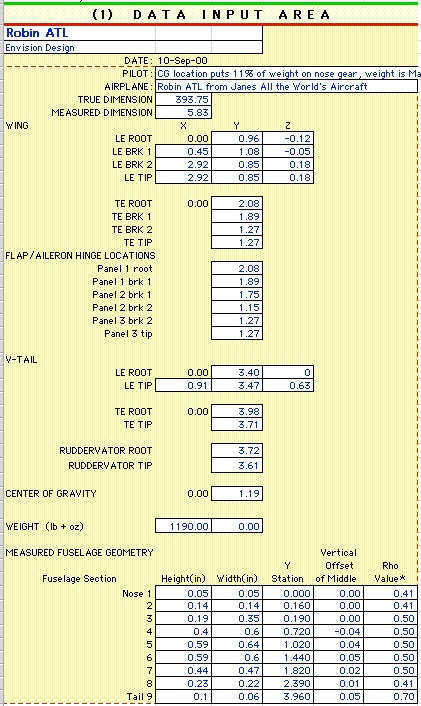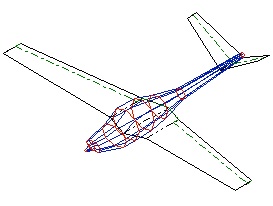Plane Geometry Inputs

Inputs to Plane Geometry
Plane Geometry has two modes: Measure and Design. In the Measure mode, inputs correspond to measurements made from a small 3-view drawing, plans, an actual model or full-scale airplane. Almost all of the inputs are dimensions. These dimensions are automatically scaled so that no hand computation is required. Metric dimensions can be entered and automatically converted to English units. The outputs are in English units. X dimensions are spanwise from the centerline, Y is lengthwise from the nose, and Z is vertical from the fuselage reference plane.
In the Design mode, most of the entries are in the form of proportions so that the size of the design may be changed with just a few new numbers. The dimensional inputs are in English units, as are the outputs
Measure
The inputs to Measure as shown to the right are divided into sections for the wing, tail and fuselage. A 3-D plot as shown above is instantly generated so that errors are immediately spotted. The entries in this example were measured from a small three view drawing in which the wing span measured 5.83 inches and the true wing span is 393.75 inches. If the geometry is intended for a model with a 60 inch span, the 393.75 dimension is simply replaced with 60. These dimensions can just as well be in metric units.
The fuselage dimensions are also taken from the three view. The procedure for all of the inputs is described in detail in the instructions.
The input block shown here is from MeasureV, for V-tail airplanes. The input block for conventional-tail airplanes, from MeasureC, is the same except for the tail entries.
Design
Inputs to Design, shown to the right, are also organized into wing, tail and fuselage sections. Miscellaneous entries are used for stability calculations.
The wing and tail data is almost all in the form of ratios and angles. The wing is sized by the span input.
The tail is sized by the pitch damping term (Cm alpha dot + Cm q horizontal). The instructions explain this and other unfamiliar terms! The instructions also provide reliable information to estimate wing pitching moment coefficients and zero lift angles.
The fuselage inputs are the same as for Measure
Inputs to DesignV are shown here. Inputs to DesignC are the same except for the tail.



